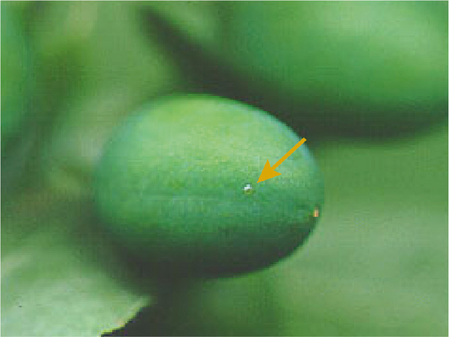Plum fruit moth
Grapholita funebrana
Appearance
The moths of the plumose moth are about 8 mm long and have a wingspan of 11-15 mm. The forewings are dull purple to gray in color, with a dark comma-shaped pattern on the wing tips, while the hindwings are almost uniformly gray-brown. Plum moths can be confused with moths of other moth species (e.g., the peach moth, Grapholita molesta). Accurate identification can only be made in the laboratory using microscopic specimens or molecular genetics.
The eggs of the plum moth are flat oval (watch-glass shaped) with a diameter of about 0.7 mm and initially translucent. During embryonic development, the eggs initially turn milky, with an orange-reddish ring. Finally, the black-headed stage develops.
The caterpillars hatching from this stage are initially whitish and subsequently turn reddish with a dark colored head. The caterpillars grow to about 10-12 mm long, are sparsely hairy and have 16 legs. The plumose moth has five caterpillar stages.
The pupal stage is 6-7 mm long and light brown in color, spun into a cocoon.



© Tomislav Jemrić, University of Zagreb, Faculty of Agriculture, Department of Pomology, Zagreb, Croatia
Biology
The plum moth can develop three partly overlapping generations per year. Hibernation largely takes place in the caterpillar stage in cracks or in bark scales on the trunk or crevices in the soil. Pupation does not occur until the following spring, when temperatures reach 10 °C or higher. The hatching of the crepuscular moths from the pupae takes place a few weeks after petal fall (from about the end of April).
The females lay 40-80 eggs singly or in small groups on the underside of young, unripe fruit from temperatures above 12 °C, mainly in the evening. After one to two weeks, the caterpillars hatch (1st larval stage) and bore into the fruit, where they feed on the flesh for about three to five weeks until the end of the caterpillar stage (5th larval stage). Usually only one caterpillar develops per fruit. The adult caterpillars of the first generation leave the fruit and pupate in a cocoon on the trunk or in the soil. The larger part of these individuals develops within one to four weeks into the moths of the second generation whose hatching begins around June. The other part of the pupated animals of the first generation, however, already goes into diapause in summer and hibernates. In climatically favorable regions, a third generation may emerge around mid-August, before the adult caterpillars of the last generation visit the overwintering sites.
Damage symptoms

From holes in infested fruits (borehole of the young caterpillar) drop-shaped gum flow emerges. Infestation by the first plum moth generation also shows premature bluish-purple discoloration of young fruits, which drop off as early as June and July. This symptom is often confused with natural fruit drop. Infestation by the second generation later in the year results in prematurely ripe fruit (distress ripening).
Inside the infested fruit, the pulp is destroyed and fecal crumbs are found as well as the caterpillar (plum maggot).
Host plants
The main host plants of the plum moth are cultivated and wild plums(Prunus domestica), plums(Prunus dom estica subsp. domestica) and apricots(Prunus armeniaca). In addition, peach(Prunus persica), sloe(Prunus spinosa), bird cherry (Prunusavium) and almond(Prunus dulcis) are also attacked.
Prevention and control
- Variety selection: Late maturing varieties are more damaged. Early-ripening varieties should therefore be grown.
- In home and small gardens, fruit infested by the plum moth (fallen) can be regularly collected and destroyed before the larvae bore out and migrate to pupate (collecting the fruit with a tarpaulin or net can be helpful; possibly help by shaking the tree; do not compost the fruit).
- Against the overwintering caterpillars, corrugated cardboard strips (in which the caterpillars spin themselves for overwintering) can be attached to the trunks from July onwards, removed before pupation is complete and destroyed with the caterpillars inside.
- Pheromones can be used against the plum moth as part of the confusion technique.
- Possible dates for biological and chemical treatment measures: seePlant Health Warning.
- Plant protection products for the control of the plum moth are listed in the register of plant protection products approved in Austria.
Last updated: 27.11.2025
automatically translated